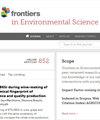Soil compounding promotes the improvement of aeolian sandy soil in the Mu Us Sandy Land
IF 3.3
3区 环境科学与生态学
Q2 ENVIRONMENTAL SCIENCES
引用次数: 0
Abstract
Aeolian sandy soil and loess soil of the Mu Us Sandy Land are used as the research material in this study to investigate the effect of soil compounding on the improvement of aeolian sandy soil and to provide a feasible approach for sand prevention and sand control. In particular, loess soils were compounded at 0%, 20%, 40%, 60%, 80%, and 100% by volume percentage of the compounded soils. The improvement benefits of compounded soils on their textural properties, water-holding capacity, and fertilizer-retention capacity at different blending ratios were evaluated. The results showed that following the compounding of aeolian sandy and loess soils, with the increase of the loess proportion, the texture type of the compounded soil transforms from sandy soil to loamy sandy soil to sandy loam to loamy soil to powdery loam. Moreover, granular gradation was observed, the bulk density gradually decreased, the capillary porosity gradually increased, and the performance of water- and fertilizer-holding properties gradually increased and strengthened. The spatial variability of compounded soil bulk density, capillary porosity, and the water-holding and fertilizer-retention properties was almost entirely controlled by the proportion of loess soil. A theoretical basis is provided in this study for aeolian sandy soil improvement in the Mu Us Sandy Land that can be extended to similar areas, providing a feasible sand management approach.土壤复合化促进了木乌苏沙地风化沙土的改良
本研究以乌苏沙地的风化沙土和黄土为研究材料,探讨土壤复合对风化沙土改良的影响,为防沙治沙提供一种可行的方法。其中,黄土按体积百分比分别为 0%、20%、40%、60%、80% 和 100%进行复配。评估了不同掺混比例下复合土对其纹理特性、持水能力和保肥能力的改善效果。结果表明,将风化砂土和黄土复配后,随着黄土比例的增加,复配土壤的质地类型从砂土转变为黄砂土、砂壤土、壤土和粉壤土。此外,颗粒级配出现,容重逐渐减小,毛管孔隙度逐渐增大,保水保肥性能逐渐增强。复合土壤容重、毛管孔率、保水保肥性能的空间变化几乎完全受黄土比例的控制。本研究为木乌斯沙地风化沙土改良提供了理论依据,可推广到类似地区,为沙地治理提供了可行的方法。
本文章由计算机程序翻译,如有差异,请以英文原文为准。
求助全文
约1分钟内获得全文
求助全文
来源期刊

Frontiers in Environmental Science
Environmental Science-General Environmental Science
CiteScore
4.50
自引率
8.70%
发文量
2276
审稿时长
12 weeks
期刊介绍:
Our natural world is experiencing a state of rapid change unprecedented in the presence of humans. The changes affect virtually all physical, chemical and biological systems on Earth. The interaction of these systems leads to tipping points, feedbacks and amplification of effects. In virtually all cases, the causes of environmental change can be traced to human activity through either direct interventions as a consequence of pollution, or through global warming from greenhouse case emissions. Well-formulated and internationally-relevant policies to mitigate the change, or adapt to the consequences, that will ensure our ability to thrive in the coming decades are badly needed. Without proper understanding of the processes involved, and deep understanding of the likely impacts of bad decisions or inaction, the security of food, water and energy is a risk. Left unchecked shortages of these basic commodities will lead to migration, global geopolitical tension and conflict. This represents the major challenge of our time. We are the first generation to appreciate the problem and we will be judged in future by our ability to determine and take the action necessary. Appropriate knowledge of the condition of our natural world, appreciation of the changes occurring, and predictions of how the future will develop are requisite to the definition and implementation of solutions.
Frontiers in Environmental Science publishes research at the cutting edge of knowledge of our natural world and its various intersections with society. It bridges between the identification and measurement of change, comprehension of the processes responsible, and the measures needed to reduce their impact. Its aim is to assist the formulation of policies, by offering sound scientific evidence on environmental science, that will lead to a more inhabitable and sustainable world for the generations to come.
 求助内容:
求助内容: 应助结果提醒方式:
应助结果提醒方式:


